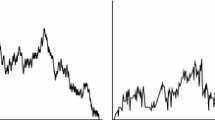Abstract
We are concerned with permutations taken uniformly at random from the symmetric group. Firstly, we study the probability of a permutation missing short cycles. Secondly, the result is employed to establish a formula for total variation distance between the process of multiplicities of cycle lengths in a random permutation and a process of independent Poisson random variables. We apply an analytic approach originated in number theory (K. Gyory et al. (Eds.) in Number Theory in Progress, 1999).
Similar content being viewed by others
References
Arratia, R., Tavaré, S.: The cycle structure of random permutations. Ann. Probab. 20, 1567–1591 (1992)
Arratia, R., Barbour, A.D., Tavaré, S.: Logarithmic Combinatorial Structures: A Probabilistic Approach. EMS Monographs in Mathematics. EMS Publishing House, Zürich (2003)
Bender, E.A., Mashatan, A., Panario, D., Richmond, L.B.: Asymptotics of combinatorial structures with large smallest component. J. Comb. Theory Ser. A 107, 117–125 (2004)
Granville, A.: Cycle lengths in a permutation are typically Poisson. J. Comb. 13(4), R107 (2006)
Hildebrand, A.: The asymptotic behavior of the solutions of a class of differential-difference equations. J. Lond. Math. Soc. 42, 11–31 (1990)
Hildebrand, A., Tenenbaum, G.: On a class of difference differential equations arising in number theory. J. d’Analyse 61, 145–179 (1993)
Manstavičius, E.: Remarks on the semigroup elements free of large prime factors. Lith. Math. J. 32, 400–409 (1992)
Manstavičius, E.: On permutations missing short cycles. Lietuvos matem. rink. 42, 1–6 (2002)
Panario, D., Richmond, B.: Smallest components in decomposable structures: Exp–Log class. Algorithmica 29, 205–226 (2001)
Stark, D.: Explicit limits of total variation distance in approximations of random logarithmic assemblies by related Poisson processes. Comb. Probab. Comput. 6, 87–105 (1997)
Tenenbaum, G.: Introduction to Analytic and Probabilistic Number Theory. Cambridge University Press, New York (1995)
Tenenbaum, G.: Crible d’Ératosthène et modèle de Kubilius. In: Number Theory in Progress, Proc. Conf. in Honor of Andrzej Schinzel, Zakopane, Poland (1997). Gyory, K., Iwaniec, H., Urbanowicz, J. (Eds.), Walter de Gruyter, Berlin, pp. 1099–1129 (1999)
Warlimont, R.: Arithmetical semigroups, II: sieving by large and small prime elements, sets of multiples. Manuscripta Math. 71, 197–221 (1991)
Zacharovas, V.: Voronoi summation formula and multiplicative functions on permutations. Ramanujan J. 24, 289–329 (2011)
Author information
Authors and Affiliations
Corresponding author
Rights and permissions
About this article
Cite this article
Manstavičius, E., Petuchovas, R. Local probabilities and total variation distance for random permutations. Ramanujan J 43, 679–696 (2017). https://doi.org/10.1007/s11139-016-9786-0
Received:
Accepted:
Published:
Issue Date:
DOI: https://doi.org/10.1007/s11139-016-9786-0
Keywords
- Symmetric group
- Permutation
- Cycle
- Total variation distance
- Dickman’s function
- Buchstab’s function
- Poisson random variables



